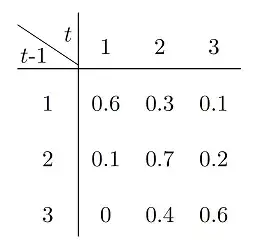I have a homogeneous Markov chain with transition matrix
I want to compute $P(Y_1 = 1| Y_2=2)$ where $Y_t, t=1,2$ is the observation at time $t$ and $Y_0=3$. I tried with Bayes' rule, so
$$P(Y_1 = 1| Y_2=2)= \frac{P(Y_2=2|Y_1=1)*P(Y_1=1)}{P(Y_2=2)}.$$
But from the transition matrix I can get only $P(Y_2=2|Y_1=1)=0.3$. How do we compute marginal probabilities $P(Y_2=2)$ and $P(Y_1=1)$ from a transition matrix?
